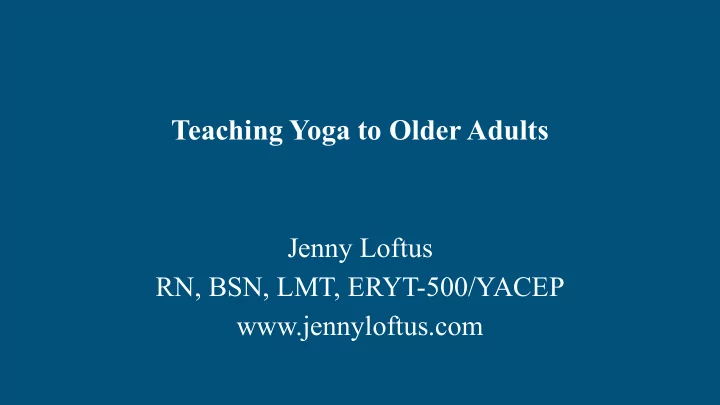

Teaching Yoga to Older Adults Jenny Loftus RN, BSN, LMT, ERYT-500/YACEP www.jennyloftus.com
Attributes of aging ● Self acceptance ● Understanding life purpose More freedom, less responsibility, more time and resources for pursuits of passion instead of obligation ● U curve of happiness ○ Bottom of the curve is midlife, happiness increases as we age ● Fruits of our labors over our lifetime are seen and felt, we reap what we sow ● Our Elders have much to teach us, much to contribute
Challenges of Aging ● Vision, hearing, mobility loss ● Changing body, mental acuity, lifestyle, energy levels ● Illness ● Impermanence, loss
Loneliness Dr Vivek Murthy Surgeon general report 2017 ● Describes loneliness as a public health crisis ● 43% of older adults report feeling lonely regularly ● 28% of seniors live alone ● Covid Isolation
Yogic Lifestyle Practices to support older adults ● Sanga~ positive social connections ● Breath work ● Restoratives ● Yoga Nidra ● Asana, learning modifications to respect changing needs ● Movement that bring joy and ease ● Yogic philosophy
Teaching Yoga to Older Adults ● Intimidating for older people to join a yoga class, esp. vinyasa ● Provide an aura of acceptance as the teacher ● Celebrate age diversity in your classes ● Get students to know each other, partner work ● Teach to the least common denominator of physical ability ● Give modifications ● Know how to use props to assist ● Give permission and guidance to stay in ROM, pace, comfort, effort
Continued... ● Slow down ● Good lighting and sound ● Position yourself for those who are hearing or visually impaired ● Speak slower, have pauses, repeat your cues (mental processing speed changes with age) ● Give more time to warm up and for transitions
Balance challenges ● Balance challenges contribute to decreased mobility, increased fear, increase potential for falls and injury ● Sensation changes in legs and feet, Diabetes, Peripheral Neuropathy ● History of Stroke ● Orthostatic Hypotension ● Vision Changes ● Vestibular system changes ● Medication side effects ● Arthritis, changes in joint function ● Decreased muscle strength
Teaching balance ● Encourage acceptance ● Challenge balance regularly ● Use the wall and props ● Slow down, mental focus and breath moment by moment ● Alignment of spine ● Yielding to know relationship with earth ● Increase stability and agility ● For orthostatic hypotension ○ Avoid constant up and down ○ Central line squeeze
Strengthen key muscle groups for balance: ● Transverse abdominus and Obliques ● Gluteus medius and minimus ● TFL ● Peroneals ● Feet
Osteoporosis Loren Fishman MD 2016 Topics in Geriatric Rehabilitation ● 12 yoga poses a day increased bone density in femurs, hips and vertebrae
Yoga for strong bones ● Weight bearing exercises ● Load on muscles increases load on bones, load on ligaments does not. Build muscles, build bones. ● Hold Poses, ideally 20-60 seconds ● Calming effects of yoga decreases cortisol (cortisol breaks down bone) ● Weight bearing cardio~ walking, bouncing, jumping~ transfers shock through bones to stimulate growth ● Body of vertebrae can “honeycomb” and weaken with osteoporosis
Osteoarthritis and other Joint problems ● Move within available ROM ● Change vectors of movement for increased ROM ● Skip or modify vinyasa flow ● Decrease repetitive movements ● Give time to seek alignment ● Modify and use props
Prop use for Osteoarthritis ● Blocks for knees against wall in lunges ● Blocks between thighs for chair pose and plank ● Low stable blocks under forearms to take load off wrists ● Wedge for wrists or weight bear on forearms ● Chairs for seated and standing poses
Hip Replacements ● Follow guidance of MD, PT ● Work within ROM, use props to support ● Pelvis above knees while seated, support under knees ● Allow pelvis to follow front leg in standing poses (healthier for SI joints as well), lessen the depth of standing poses ● Move slowly, avoid constant up and down from floor ● First 8 weeks and then as tolerated: ○ Avoid deep hip flexion (past 90 degrees) ○ Avoid crossing legs (adduction)
Knee Replacements ● Follow guidance of MD, PT ● Flexion and Rotation are difficult post op ● Bolster behind knees for child’s pose ● Seated and standing postures in a chair ● Seated postures sitting on bolster, support under knees ● Offer modifications with thigh stretches, use straps ● Avoid knees on the floor, use a blanket under knee if tolerated ● Blocks against wall for lunges, decrease depth for standing poses ● Chair pose with pelvis against wall and/or block between thighs ● Move slowly, avoid up and down off floor
Cautions ● Twists ○ Seated twists have most pressure on vertebral bodies and discs ○ Supine twists are the safest ● Inversions, esp. Shoulder stand ○ Increases pressure on carotid arteries , contraindicated with Heart Disease ○ Increases intraocular pressure, contraindicated with HTN, Glaucoma ○ Inverting with weak esophageal and pyloric sphincters can exacerbate GERD ○ Increases weight bearing on cervical vertebrae, contraindicated with osteoporosis
Recommend
More recommend